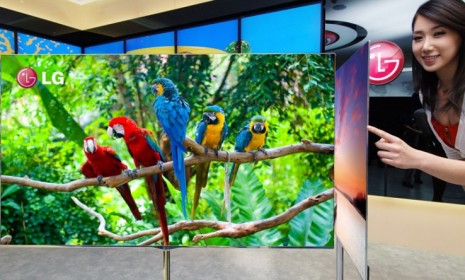LG's 'impossibly thin' TV set: 4 talking points
A big-screen TV that is skinnier than an iPhone is making waves before it even debuts next week

Every year, the Consumer Electronics Show (CES) in Las Vegas unveils the future's groundbreaking new gadgets. And every year, at least one buzzy piece of technology ends up stealing the show. The early frontrunner ahead of this year's event, which will be held next week, is a super-thin, 55-inch OLED flatscreen TV, the first of its kind to be offered to U.S. consumers. Some are saying it will be the "best TV ever." Here, four talking points:
1. It's probably thinner than your phone
The Week
Escape your echo chamber. Get the facts behind the news, plus analysis from multiple perspectives.

Sign up for The Week's Free Newsletters
From our morning news briefing to a weekly Good News Newsletter, get the best of The Week delivered directly to your inbox.
From our morning news briefing to a weekly Good News Newsletter, get the best of The Week delivered directly to your inbox.
While smaller OLED (organic light-emitting diodes) TV sets have been available in the past, none of them came close to the display size of LG's 55-incher. The South Korean electronics company says this TV set is only 4 millimeters thick — "impossibly thin," says Charlie White at Mashable. In contrast, the latest iPhone is over twice as thick, at 9.3 millimeters. The TV reportedly weighs in at a feathery 16.5 pounds.
2. And boasts unrivaled display power
The "key advantage" of OLED technology, says The Wall Street Journal, is that the panels emit light. That eliminates the need for a backlight, allowing the display to be kept super-thin. OLED screens are already outfitted on smartphones everywhere, using pixels capable of emitting red, green, blue, and white to produce accurate tones onscreen. "Traditionally, OLED offers higher contrast than both LCD and plasma," says Ty Pendlebury at CNET, and LG says this new technology is easier and more economic to produce as well.
3. But it will cost a lot… at least first
A free daily email with the biggest news stories of the day – and the best features from TheWeek.com
One analyst quoted by The Wall Street Journal estimates that the price for the 55-inch model will start at around $8,000 when it (supposedly) launches in the third quarter of 2012. In 2013, that should fall below $4,000 "as sales volumes increase and companies find ways to manufacture the sets less expensively."
4. The future looks bright
What makes the technology so "promising" is that giant OLED screens "can be printed onto razor-thin surfaces using a process akin to an inkjet printer," says Mashable's White, "theoretically making them even cheaper to produce than today's LCD and plasma screens" — at least at some point down the line. "No question about it," White says: "You're looking at the TV of the future."
Sources: CNET, Mashable, MSNBC, Wall St. Journal
-
 Political cartoons for December 6
Political cartoons for December 6Cartoons Saturday’s political cartoons include a pardon for Hernandez, word of the year, and more
-
 Pakistan: Trump’s ‘favourite field marshal’ takes charge
Pakistan: Trump’s ‘favourite field marshal’ takes chargeIn the Spotlight Asim Munir’s control over all three branches of Pakistan’s military gives him ‘sweeping powers’ – and almost unlimited freedom to use them
-
 Codeword: December 6, 2025
Codeword: December 6, 2025The daily codeword puzzle from The Week